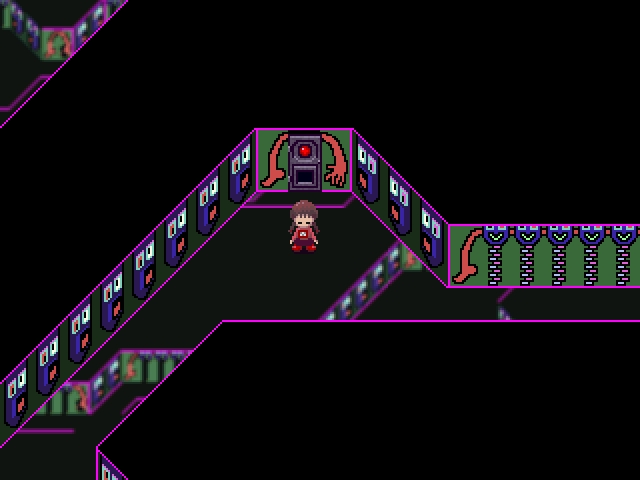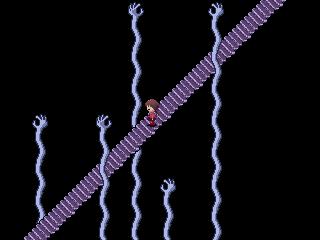When anyone wants to talk about games as art, Yume Nikki should be the first game that is mentioned. An exquisitely detailed exploration of one unconscious, Yume Nikki is both the follow-up to LSD: Dream Emulator that we desperately needed and a new gold standard in the murky waters of exploration games.
The elevator pitch is deceptively simple. You play as Madotsuki (窓付き, lit. windowed) while she dreams, where you explore and collect 24 various “effects” that change how you can interact with the world. While this seems like a simplistic setup, what is around the game is what makes it so special.
Impatience is your absolute worst enemy in Yume Nikki. You’re in Madotsuki’s apartment. The TV can be turned on and off, but it doesn’t receive any channels. There’s a Famicom where you can play a bizarre game of futility called NASU. Her desk allows her to write in her diary as a save game feature. You’re also able to go outside on the balcony. However, you can’t leave your room. Whenever you attempt to interact with the door, Madotsuki shakes her head no. The only way out of the room at all is through the bed.
This is why the game is worth playing. For someone of relatively few words, Madotsuki’s inner life is a rich tapestry of isolation, anxiety, and Mesoamerican imagery. In addition to the hub world with 12 doors that lead to large overworlds that appear in a nexus after she initially falls asleep, there are over 100 unique interconnected locations to explore. While that might not sound entirely impressive compared to the open-world games of today, Yume Nikki is arguably the most brilliant game when it comes to making use of its space.
Every world is a vivid, haunting experience. From the lonely underground mall to the dazzling, populous neon world, every place you visit in Yume Nikki is something you will remember. There’s an entirely Famicom-inspired world that takes clear inspiration from Mother and is even complete with an in-game ending “glitch” where the Famicom crashes and Madotsuki wakes up from her dream. There’s an area fans refer to as Hell, a giant red maze full of dead ends and disorientingly similar routes that obliterate your sense of direction. Every single tile set that makes up Yume Nikki is both necessary and breathtaking. Its world is as rich and varied as a grandmother’s quilt, created over what seems like eons into such a rich, multifaceted object that every aspect of it serves to draw you in. The visual playground that Yume Nikki displays simply cannot be matched, having the sheer punching weight of a phenomenal aesthetic palette that has prevented itself from being dated.
Yume Nikki‘s sound design exists solely to prop up the imagery. Unmelodious, rhythmic, humming drones are there to pull you further into the trance of Madotsuki’s inner life. The soundtrack could be compared to noise or sound collage, and while that isn’t entirely off kilter, there’s more of a vibration to it, a hypnotic element that always seems to perfectly match whatever surreal landscape surrounds you.

Further aiding Yume Nikki‘s focus on exploration are the effects. These are the game’s term for items that Madotsuki can use to impact the world around her, through physical interaction or changing her own properties. They can often be very useful — like a bicycle that increases your movement speed or turning Mado’s head into a lamp to see in the game’s darker areas — but they can also dip into the absurd and useless, such as turning Madotsuki into a neon sign or removing her face. Most notable of the effects is the knife, which can not only scare away the few enemies the game has (which annoyingly send you back to the waking world) but also be used to trigger events.
The events are Yume Nikki‘s frontal display of artistic meaning. They’re caused by using an effect (usually the knife) on a specific part of the dream worlds and reward your curiosity with a small animation. They can range from small changes, such as Mado waking up with a crick in her neck, to drastic occurrences, such as the infamous Uboa event, where Madotsuki is chased by an enormous bleeding monster set to a haunting few sounds. The events are often well hidden, but it’s always worth your time to explore and see Kikiyama, the creator of the game, peel back another layer of the onion.
Yume Nikki is a game that so perfectly captures dreamlike imagery that many people experience it in an uncanny way, as it seems incredibly familiar but also alien and frightening. It’s something you play right before bed, sleepy but unable to close your eyes, and let your mind wander. Games have come before Yume Nikki that have done similar things, and there are certain to be games after. Never have there been games that have nailed it down this goddamn well. Ten out of ten.







Published: Feb 22, 2018 06:18 am